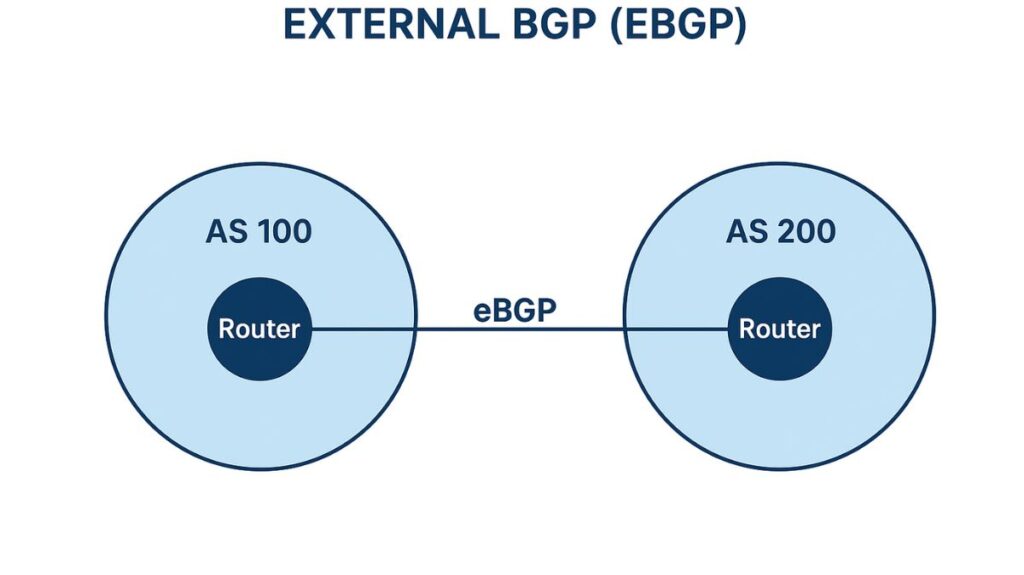What is eBGP?

An application of the Border Gateway Protocol (BGP) called External Border Gateway Protocol (eBGP) is used to transfer routing data between several administrative domains. BGP is an Exterior Gateway Protocol (EGP) that was created especially for TCP/IP networks’ interdomain routing.
This is a thorough description of eBGP:
Core Purpose and Definition
Facilitating communication and routing between networks under the authority of various organizations is eBGP’s primary function.
- Inter-AS Communication: When BGP peers (routers) are situated in separate autonomous systems (AS), an eBGP session takes place. The two BGP peers’ distinct AS numbers are the defining feature.
- Interconnectivity: eBGP enables communication and route information sharing between various separate networks, such as those operated by Internet service providers (ISPs) or between an organization and an ISP. The formation of the global Internet backbone depends on this technique.
- Operation: eBGP functions at an autonomous system’s edge or border routers. It facilitates the exchange of knowledge between networks regarding how to send messages to locations outside of their own network.
- Route Exchange: Its main purpose is to make it easier for traffic to move between ASs by facilitating the exchange of routes, also referred to as prefixes.
You can also read Virtual Private LAN Service VPLS: Features And Advantages
Key Characteristics and Operational Rules
eBGP has specific rules that distinguish it from Internal BGP (iBGP) to ensure stability and loop prevention when routing between independent networks.
| Characteristic | eBGP Rule |
| Peering Location | Runs between two BGP routers in different autonomous systems. |
| Administrative Distance (AD) | The default Administrative Distance is 20. This is lower than iBGP’s default of 200, making eBGP routes generally more trustworthy. |
| Next-Hop Attribute | When advertising a route to an eBGP peer, the router changes the Next-Hop address to its own interface IP address to ensure immediate reachability. |
| Loop Prevention | eBGP uses the AS_PATH attribute for loop prevention. The advertising router prepends its own AS number to the AS_PATH before sending the route. A receiving router rejects a route if it sees its own ASN present anywhere in the path. |
| Topology Requirement | Does not require full mesh topology. |
| Attribute Sending | Attributes like local preference are not sent in eBGP peers. |
| Route Propagation | Routes learned from an eBGP peer are re-advertised to all other peers, both iBGP and eBGP (subject to policy). |
Establishing the eBGP Session (Peering)
Two routers need to connect on TCP port 179 in order to become eBGP peers.
- Direct Connection (Default): The Time-to-Live (TTL) of BGP packets forwarded to a direct eBGP neighbor is usually set to 1. The requirement that eBGP peers be directly connected is enforced by this parameter.
- Non-Direct Connection (Multihop): If the peers are not directly connected, the
neighbor ebgp-multihopcommand must be used. This command changes the TTL value to allow the packet to reach the external peer over multiple hops. A path (either through an Interior Gateway Protocol or a static route) must exist to reach the peer.
- Loopback Address Peering: eBGP can also be configured using a loopback interface address (or any other operational interface). When a loopback is used, the
neighbor update-sourcecommand specifies that the TCP connection should be established using the loopback address. If loopback addresses are used, theneighbor ebgp-multihopcommand is necessary. This method is beneficial because the BGP session will not be brought down if the physical interface fails, especially if multiple paths exist between the peers.
Use Cases and Configuration
eBGP is employed in a number of situations to guarantee worldwide connectivity:
- ISP Peering: Setting up routing between two distinct ISPs is known as ISP peering.
- Enterprise Multi-Homing: For load balancing and redundancy, connect an enterprise network to many ISPs.
- Cloud and Data Center Edge Routing: Route exchange between on-premises networks and cloud providers is known as cloud and data center edge routing.
Configuration:
Configuration involves defining the BGP process, establishing neighbor relationships using the neighbor peer-ip-address remote-as peer-as-number command (where the AS number must be different), and advertising local networks.
Configuration results in one router being in one Autonomous System (e.g., AS 300) and the neighboring router being in a different one (e.g., AS 400).
The successful establishment of an eBGP peer relationship can be verified using the show ip bgp neighbors command, which indicates an “external link” and the BGP state as Established.
You can also read IPsec VTI: What is IPsec Virtual Tunnel Interface & Benefits
